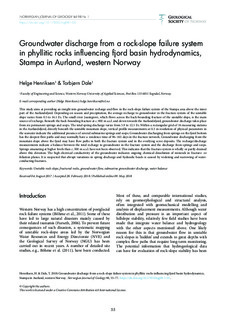| dc.contributor.author | Henriksen, Helge | |
| dc.contributor.author | Dale, Torbjørn | |
| dc.coverage.spatial | Norway, Aurland | nb_NO |
| dc.date.accessioned | 2019-03-11T07:32:53Z | |
| dc.date.available | 2019-03-11T07:32:53Z | |
| dc.date.created | 2018-06-20T14:44:25Z | |
| dc.date.issued | 2018 | |
| dc.identifier.citation | Henriksen, H., & Dale, T. (2018). Groundwater discharge from a rock-slope failure system in phyllitic rocks influencing fjord basin hydrodynamics,Stampa in Aurland, western Norway. Norwegian Journal of Geology, 98(1), 55-77. | nb_NO |
| dc.identifier.issn | 2387-5844 | |
| dc.identifier.uri | http://hdl.handle.net/11250/2589475 | |
| dc.description.abstract | This study aims at providing an insight into groundwater recharge and flow in the rock-slope failure system of the Stampa area above the inner part of the Aurlandsfjord. Depending on season and precipitation, the average recharge to groundwater in the fracture system of the unstable slope varies from 0.5 to 16.1 l/s. The small river Joastegrovi, which flows across the back-bounding fracture of the unstable slope, is the main source of recharge. Beneath the back-bounding fracture at c. 900 m a.s.l. and down towards the Aurlandsfjord, groundwater discharge takes place from six permanent springs and seeps. The total spring discharge varies from 5.9 to 12.5 l/s. Within a rectangular grid of 16 measuring stations in the Aurlandsfjord, directly beneath the unstable mountain slope, vertical profile measurements at 0.3 m resolution of physical parameters in the seawater indicate the additional presence of several submarine springs and seeps. Groundwater discharging from springs on the fjord bottom has the deepest flow paths and may normally have a residence time of 96–165 days in the fracture network. Groundwater discharging from the mountain slope above the fjord may have flow paths in both the fracture system and in the overlying scree deposits. The recharge/discharge measurements indicate a balance between the total recharge to groundwater in the fracture system and the discharge from springs and seeps. Springs emanating at higher levels than c. 300 m a.s.l. have not been observed. This indicates that the fracture system is wholly or partly drained above this elevation. The high electrical conductivity of the groundwater indicates ongoing chemical dissolution of minerals in fracture- or foliation planes. It is suspected that abrupt variations in spring discharge and hydraulic heads is caused by widening and narrowing of waterconducting fractures. | nb_NO |
| dc.language.iso | eng | nb_NO |
| dc.publisher | Norsk geologisk forening | nb_NO |
| dc.rights | Navngivelse 4.0 Internasjonal | * |
| dc.rights.uri | http://creativecommons.org/licenses/by/4.0/deed.no | * |
| dc.subject | unstable rock-slope | nb_NO |
| dc.subject | groundwater flow | nb_NO |
| dc.subject | fractured rocks | nb_NO |
| dc.subject | submarine groundwater discharge | nb_NO |
| dc.subject | water balance | nb_NO |
| dc.title | Groundwater discharge from a rock-slope failure system in phyllitic rocks influencing fjord basin hydrodynamics,Stampa in Aurland, western Norway | nb_NO |
| dc.type | Journal article | nb_NO |
| dc.type | Peer reviewed | nb_NO |
| dc.description.version | publishedVersion | nb_NO |
| dc.rights.holder | © Copyright the authors. | nb_NO |
| dc.subject.nsi | VDP::Matematikk og Naturvitenskap: 400::Geofag: 450 | nb_NO |
| dc.source.pagenumber | 55-77 | nb_NO |
| dc.source.volume | 98 | nb_NO |
| dc.source.journal | Norwegian Journal of Geology | nb_NO |
| dc.source.issue | 1 | nb_NO |
| dc.identifier.doi | 10.17850/njg98-1-05 | |
| dc.identifier.cristin | 1592692 | |
| cristin.unitcode | 203,12,7,0 | |
| cristin.unitname | Institutt for miljø- og naturvitskap | |
| cristin.ispublished | true | |
| cristin.fulltext | original | |
| cristin.qualitycode | 1 | |

